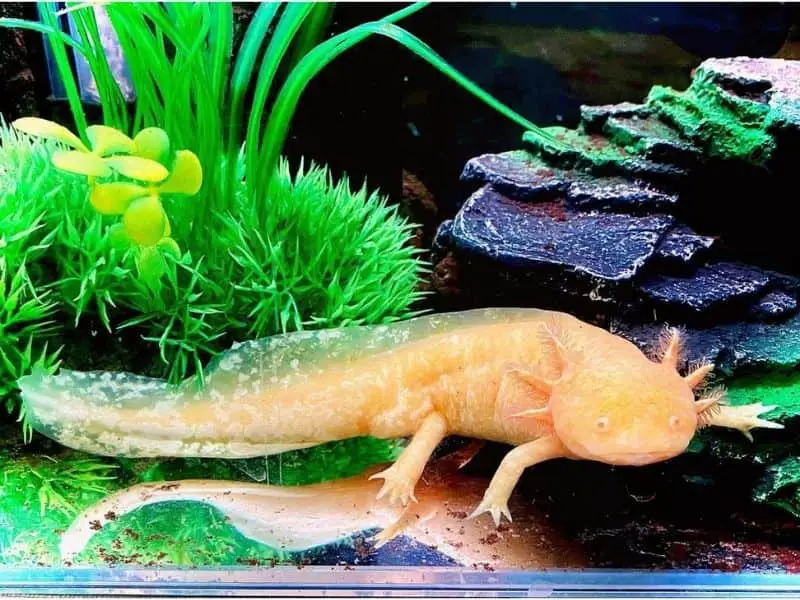Axolotls are not capable of going on land and breathing out of water because of their unique characteristics and biological development. These pets spend all their lives in watery habitats as they require a chilly temperature, controlled flow of water, and less exposure to sunlight.
Can axolotls go on land?

Axolotls cannot go on land because they are aquatic pets. The rare salamander cannot walk quickly and effectively, like other salamanders thriving on land, since its limbs are not fully developed. The limbs are functionally adapted for movement in an aquatic environment.
On land, an axolotl cannot survive for long by breathing air directly. The pet will have to rely on the capacity of air in its lungs, which tends to last within a couple of minutes or one hour.
In case your axolotl gets out of its tank by accident, especially since it is not a canny creature, do not let it exsiccate.
Prevent axolotls from going on land by ensuring their tanks or aquariums are enclosed.
Why can’t axolotls breathe out of water?
Axolotls cannot breathe out of water longer even though they possess gills and lungs. The pets have more fish-like behavioral traits. Axolotls, unlike other amphibians, only know water as their natural habitat.
An axolotl relies on its skin and gills, which should be in sustained connection with water for its normal inhaling and exhaling. The proximity of the shallow skin and cutaneous vasculature to water authorizes the dissolved oxygen to be efficiently diffused into the circulatory system and passed throughout the body. This is necessary for the normal body processes, including cellular respiration, to function.
Carbon dioxide, a primary by-product of respiration, can also be expertly expelled from the skin by diffusion when there is a connection with water. Failing to get rid of the carbon dioxide, the gas can accumulate to dangerous levels that can harm the amphibian pet.
The pet may also go to the water surface to breathe, vital in supplementing its normal mechanism for the interchange of breathing gas. This breathing option is unsustainable, only relied upon when there is no sufficient oxygen at the bottom of the water.
If you realize that your axolotls are appearing on the water surface to breathe frequently, then something is wrong with their environment.
READ ALSO: Can Axolotls Live Together? How Many Tank Mates?
Can you take axolotls out of the water?
Do not take axolotls out of the water, unless it is unavoidable. When you take axolotls away from their habitat, they turn to a secondary breathing mechanism via lungs and cheeks, which supplies little, unsustainable air.
Because axolotls are aquatic amphibians, taking them out of water may be detrimental to their health. It is not like they don’t have lungs but they are not fully formed. Hence, axolotls rely heavily on their skin and how gills work to absorb oxygen from water.
How gills work by flapping is best observed on the head and the sides of the right and left of the head of your amphibian pet. The special exterior gills have lots of arteries to promote the capture of gases of substantial volumes. The flapping of the gills triggers the movement of water adjacent to its tiny filaments, promoting excellent gas exchange.
If the gills are not relaxed and flapped rapidly, that is a sign of either stress or an infection. As well, the flickering of the gills may be an indication that the pet is running out of oxygen from its lungs. You will thus need to know what to do, such as ensuring the axolotl has appropriate water quality.
How long can axolotls survive out of water?
Axolotls cannot survive out of water for an extended period. There is no recognized time frame of how long an axolotl can take to survive outside its watery habitat. Remember though that the more time an axolotl spends on land, the more the skin dries out and the lungs’ oxygen runs out, which greatly compromises its ability to survive.
Every species of an axolotl is different and may tolerate the environment outside of water differently. Generally, within minutes of taking axolotls out of the water, you should start to notice a bodily struggle and deterioration in health.
Axolotls taken out of their aquatic habitat for longer will need even more time to fully recover from stress and physical exhaustion. Some of your amphibian friends may even die, a tragedy you need to avoid.
Removing an axolotl from water can reduce the effectiveness of its glossy skin cover against potential fungal/bacterial attacks. Therefore, the Mexican walking fish may suffer from an infection, leading to its death. The eroding of the mucus-like skin substance also compromises its ability in maintaining and preserving the vital balance of fluids and electrolytes for the normal and effective functioning of organs and cells.
Taking the pet out of water may only be done during tank cleaning and only for a few minutes. Even better, transfer the pet into another clean tank as you sanitize the primary tank to be safe and conducive for living. Alternatively, replace a volume of the water each week to avoid taking the pet out of its aquarium.
Freshwater test kits provide a reliable way of monitoring the water quality in an axolotl tank.
Precautions when taking your axolotl out of its tank
Axolotl has a delicate protective layer on its skin, and thus unlike fish, should not be handled roughly and frequently. Taking your axolotl out of its tank promotes handling, which often leaves it stressed out or sick.
Precautions to observe when taking your axolotl out of its watery environment include:
Clean your hands before handling your pet
If you intend to hold the amphibian pet, you must thoroughly wash your hands. This is to avoid exposing the delicate, thin skin of an axolotl to bacteria that may cause an infection, apart from other health issues. Also, wash your hands after touching the pet for your safety and general health.
Avoid stroking the pet
Axolotls are like cats since they do not revel in being stroked, particularly for extended periods. Trying to stroke the walking fish may make it go crazy, resulting in distress and nervousness.
Your handling must be gentle so that it does not get frightened. Remember that it may take you longer to establish a bond with a pet that is afraid of your contact.
Avoid touching its head and gills
The head and gills of an axolotl are the most sensitive body parts to touch. The parts are built of a tender matter, which can be damaged by strong handling. Damaging the gills of an axolotl will leave it susceptible to numerous health issues such as fungus and bacterial infection.
To have a chance of touching your axolotl favorably, insert your hand into its watery habitat. Then, give the pet time to familiarize itself with your hand. The aquatic pet may touch or even prefer to settle on your hand, a sign it is comfortable in your presence and with your handling.
If the axolotl has not touched or rested on your hand, initiate contact by touching its tail and or belly. Those body parts are a little bit not prone to damage or upsetting the pet when touched.
For the safety of your axolotl, refrain from frequently handling it. The pet is not people-friendly, that is why even in captivity it prefers to stay in hiding. Your contact will get the axolotl stressed instead of making it happy. So, stay away from handling the pet as your hand may be bitten.
Avoid placing more than one axolotl in a tank. No need to provide even a tank mate like fish. Axolotls do not like to socialize. They will nip at each other, exhibiting cannibalistic behavior.
If it is a must that you put them in the same tank, ensure axolotls living together are of the same age and size. Since adult axolotls may prey on their babies, always put them in separate tanks. You can remove a young axolotl from a tank or an aquarium using a net.
In conclusion, other salamanders use gills in water when young, and when mature they use properly developed lungs on land. However, axolotls breathe with their gills and skin throughout their life cycle since they have fully adapted to live underwater. If you are holding an axolotl out of water, make sure it remains wet until the time, within a few minutes, you put it back.
READ NEXT: Why is My Axolotl Floating? Reasons + What to Do
